Accounts and Finance: Capital Budgeting and Cost Analysis
VerifiedAdded on 2022/11/17
|10
|869
|135
Report
AI Summary
This report provides a comprehensive analysis of capital budgeting techniques and the cost of capital. Part A focuses on capital budgeting, evaluating an upgrade project for Mars Australia and New Zealand using payback period, net present value (NPV), and profitability index. The report includes calculations for after-tax cash flows, payback period, NPV, and profitability index, concluding with a recommendation against the project due to a negative NPV. The report also discusses the use of equalized NPV for comparing projects with unequal lives. Part B delves into the cost of capital, examining the impact of debt and equity on the Weighted Average Cost of Capital (WACC) and its effect on cash availability. The report identifies how changes in capital structure, specifically the proportion of debt, influence the WACC and the financial position of the company, Cloudstreet Limited, highlighting the benefits of increased debt in terms of tax and cash flow.
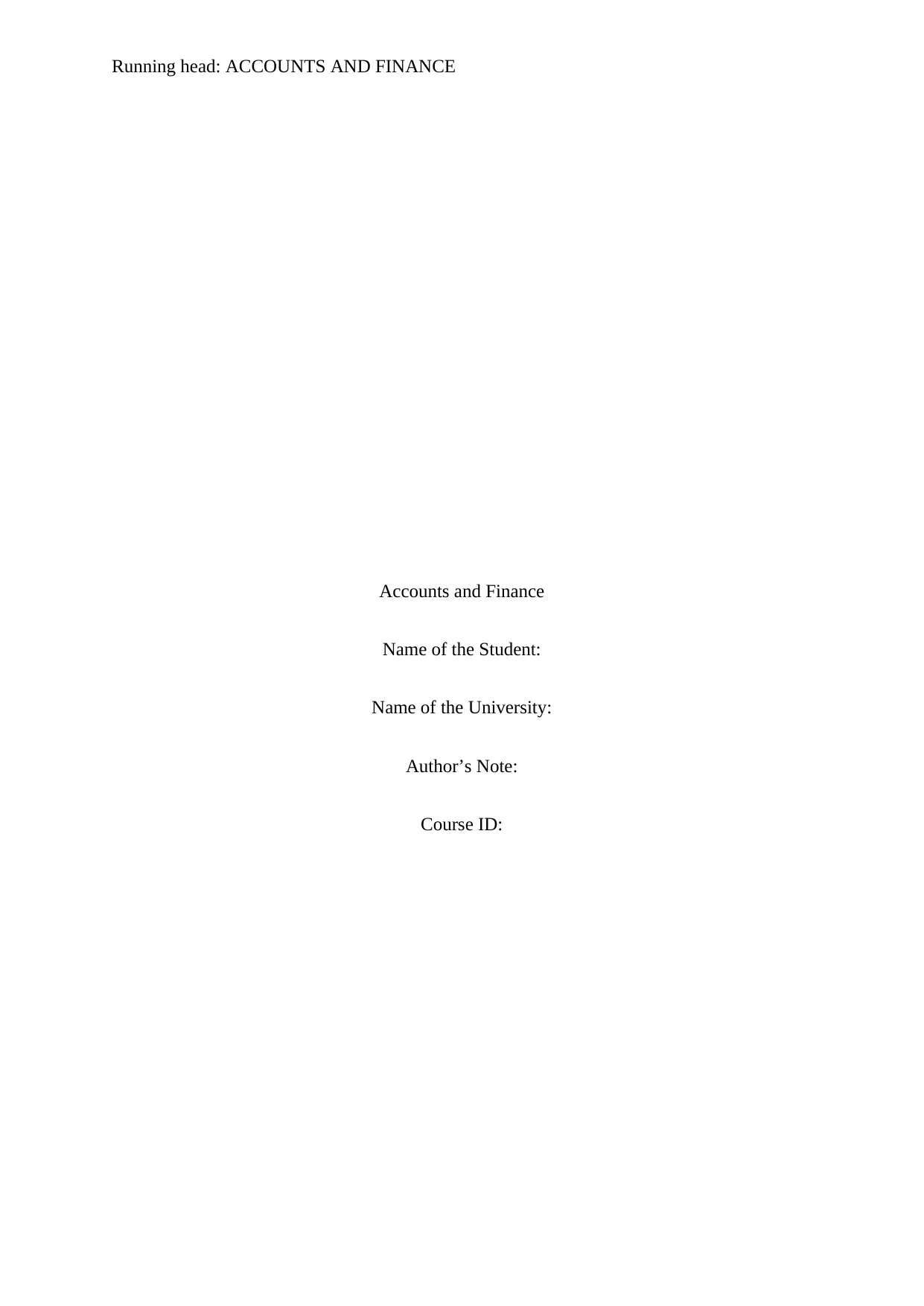
Running head: ACCOUNTS AND FINANCE
Accounts and Finance
Name of the Student:
Name of the University:
Author’s Note:
Course ID:
Accounts and Finance
Name of the Student:
Name of the University:
Author’s Note:
Course ID:
Paraphrase This Document
Need a fresh take? Get an instant paraphrase of this document with our AI Paraphraser

1ACCOUNTS AND FINANCE
Table of Contents
Part A: Capital Budgeting..........................................................................................................2
Question (i);...........................................................................................................................2
Question (ii):..........................................................................................................................3
Question (iii):.........................................................................................................................4
Requirement (a):.................................................................................................................4
Requirement (b):................................................................................................................5
Part B: Cost of Capital...............................................................................................................6
Question (a):...........................................................................................................................6
Question (b):...........................................................................................................................6
Question (c):...........................................................................................................................6
Question (d):...........................................................................................................................7
Question (e):...........................................................................................................................7
References:.................................................................................................................................9
Table of Contents
Part A: Capital Budgeting..........................................................................................................2
Question (i);...........................................................................................................................2
Question (ii):..........................................................................................................................3
Question (iii):.........................................................................................................................4
Requirement (a):.................................................................................................................4
Requirement (b):................................................................................................................5
Part B: Cost of Capital...............................................................................................................6
Question (a):...........................................................................................................................6
Question (b):...........................................................................................................................6
Question (c):...........................................................................................................................6
Question (d):...........................................................................................................................7
Question (e):...........................................................................................................................7
References:.................................................................................................................................9

2ACCOUNTS AND FINANCE
Part A: Capital Budgeting
Question (i);
After-tax cash flows:
Working Notes:
Part A: Capital Budgeting
Question (i);
After-tax cash flows:
Working Notes:
⊘ This is a preview!⊘
Do you want full access?
Subscribe today to unlock all pages.

Trusted by 1+ million students worldwide
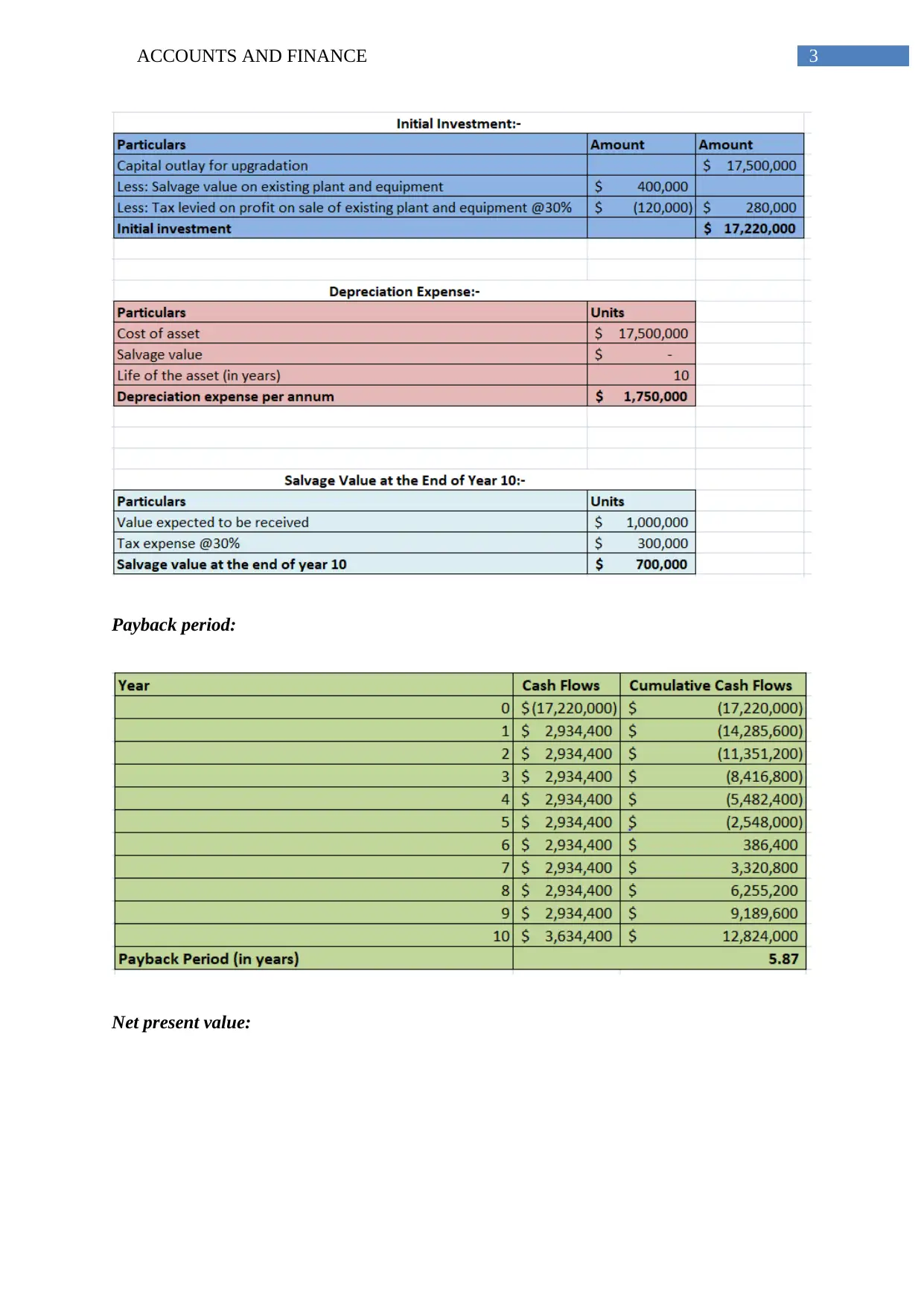
3ACCOUNTS AND FINANCE
Payback period:
Net present value:
Payback period:
Net present value:
Paraphrase This Document
Need a fresh take? Get an instant paraphrase of this document with our AI Paraphraser
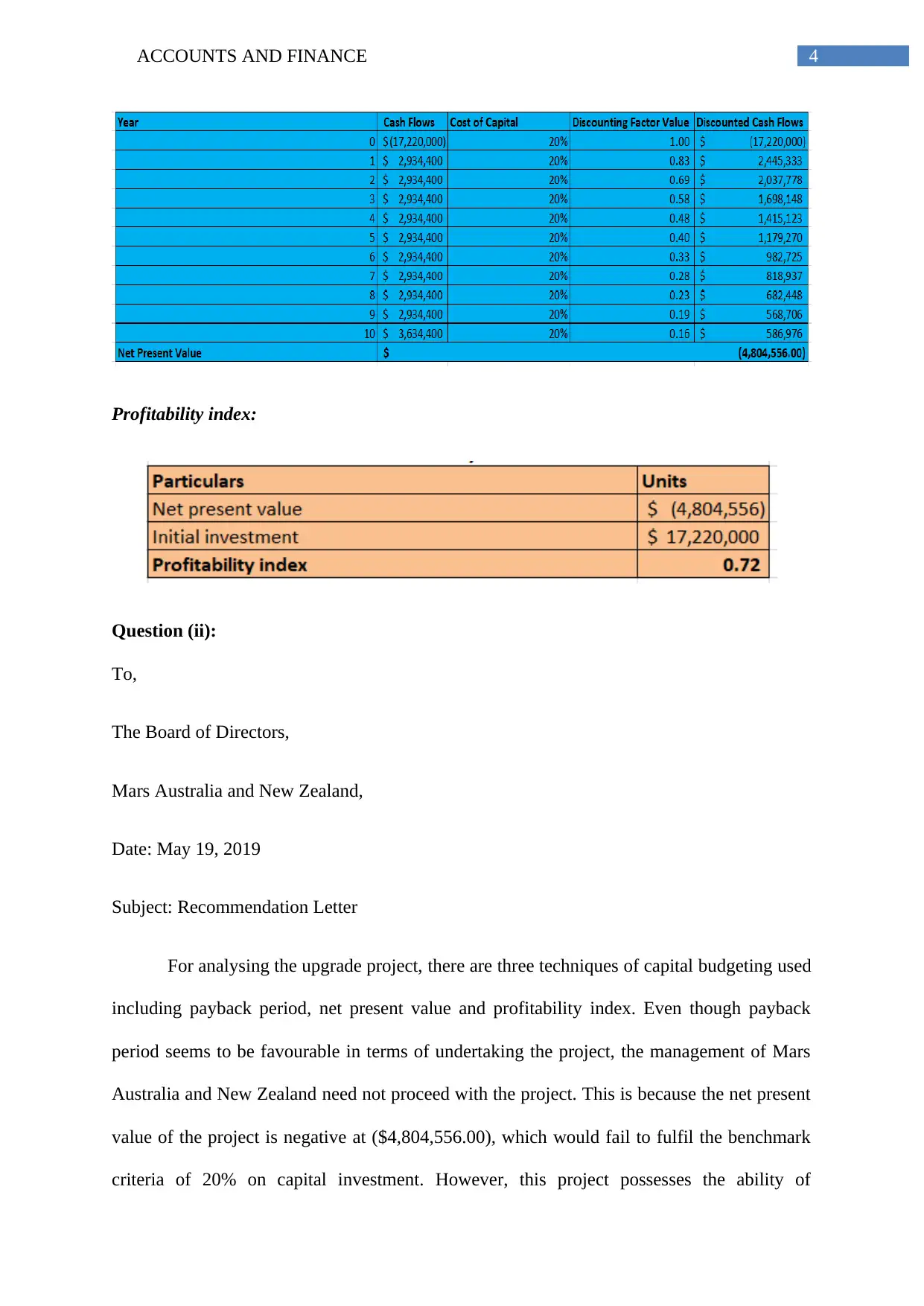
4ACCOUNTS AND FINANCE
Profitability index:
Question (ii):
To,
The Board of Directors,
Mars Australia and New Zealand,
Date: May 19, 2019
Subject: Recommendation Letter
For analysing the upgrade project, there are three techniques of capital budgeting used
including payback period, net present value and profitability index. Even though payback
period seems to be favourable in terms of undertaking the project, the management of Mars
Australia and New Zealand need not proceed with the project. This is because the net present
value of the project is negative at ($4,804,556.00), which would fail to fulfil the benchmark
criteria of 20% on capital investment. However, this project possesses the ability of
Profitability index:
Question (ii):
To,
The Board of Directors,
Mars Australia and New Zealand,
Date: May 19, 2019
Subject: Recommendation Letter
For analysing the upgrade project, there are three techniques of capital budgeting used
including payback period, net present value and profitability index. Even though payback
period seems to be favourable in terms of undertaking the project, the management of Mars
Australia and New Zealand need not proceed with the project. This is because the net present
value of the project is negative at ($4,804,556.00), which would fail to fulfil the benchmark
criteria of 20% on capital investment. However, this project possesses the ability of
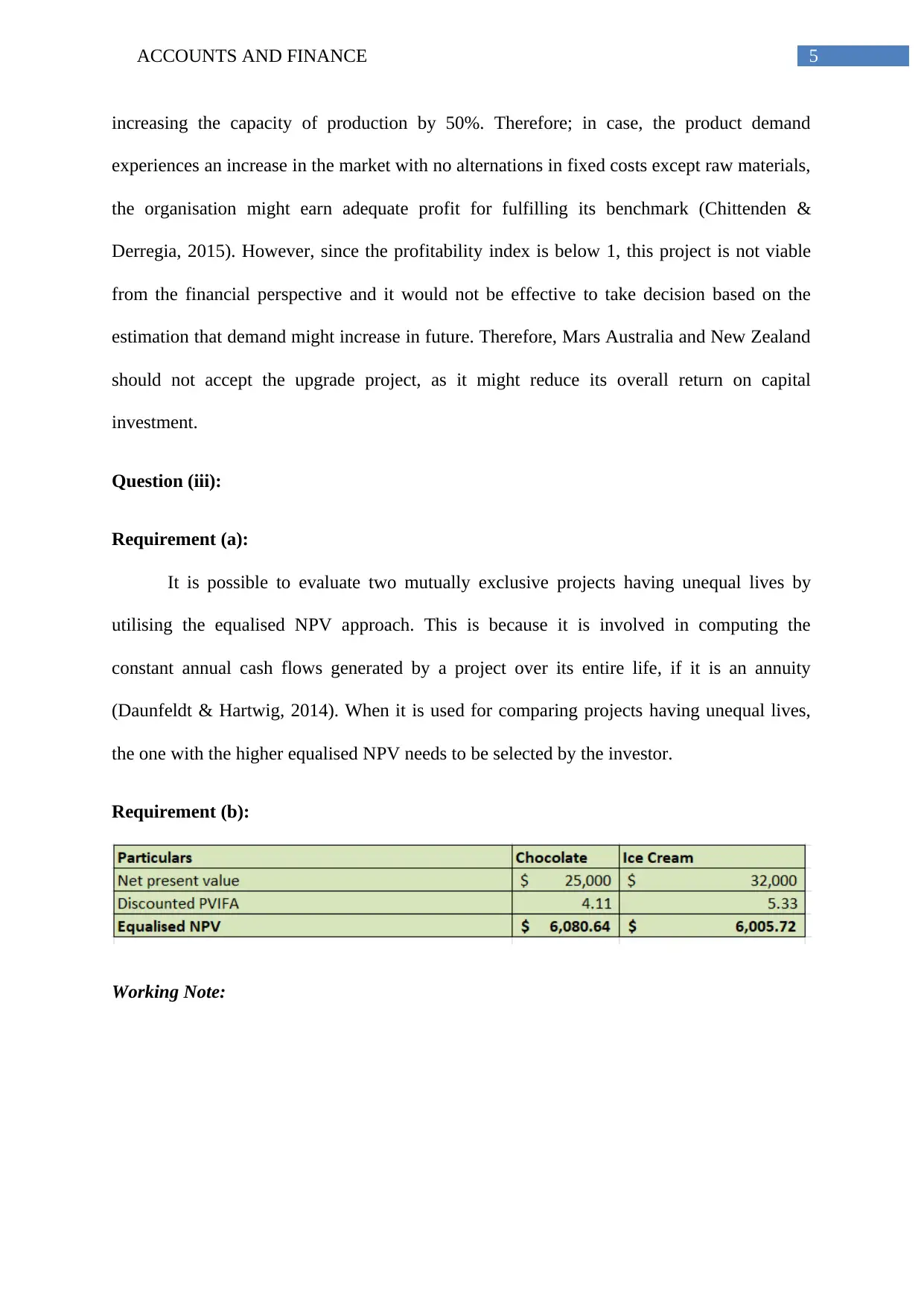
5ACCOUNTS AND FINANCE
increasing the capacity of production by 50%. Therefore; in case, the product demand
experiences an increase in the market with no alternations in fixed costs except raw materials,
the organisation might earn adequate profit for fulfilling its benchmark (Chittenden &
Derregia, 2015). However, since the profitability index is below 1, this project is not viable
from the financial perspective and it would not be effective to take decision based on the
estimation that demand might increase in future. Therefore, Mars Australia and New Zealand
should not accept the upgrade project, as it might reduce its overall return on capital
investment.
Question (iii):
Requirement (a):
It is possible to evaluate two mutually exclusive projects having unequal lives by
utilising the equalised NPV approach. This is because it is involved in computing the
constant annual cash flows generated by a project over its entire life, if it is an annuity
(Daunfeldt & Hartwig, 2014). When it is used for comparing projects having unequal lives,
the one with the higher equalised NPV needs to be selected by the investor.
Requirement (b):
Working Note:
increasing the capacity of production by 50%. Therefore; in case, the product demand
experiences an increase in the market with no alternations in fixed costs except raw materials,
the organisation might earn adequate profit for fulfilling its benchmark (Chittenden &
Derregia, 2015). However, since the profitability index is below 1, this project is not viable
from the financial perspective and it would not be effective to take decision based on the
estimation that demand might increase in future. Therefore, Mars Australia and New Zealand
should not accept the upgrade project, as it might reduce its overall return on capital
investment.
Question (iii):
Requirement (a):
It is possible to evaluate two mutually exclusive projects having unequal lives by
utilising the equalised NPV approach. This is because it is involved in computing the
constant annual cash flows generated by a project over its entire life, if it is an annuity
(Daunfeldt & Hartwig, 2014). When it is used for comparing projects having unequal lives,
the one with the higher equalised NPV needs to be selected by the investor.
Requirement (b):
Working Note:
⊘ This is a preview!⊘
Do you want full access?
Subscribe today to unlock all pages.

Trusted by 1+ million students worldwide
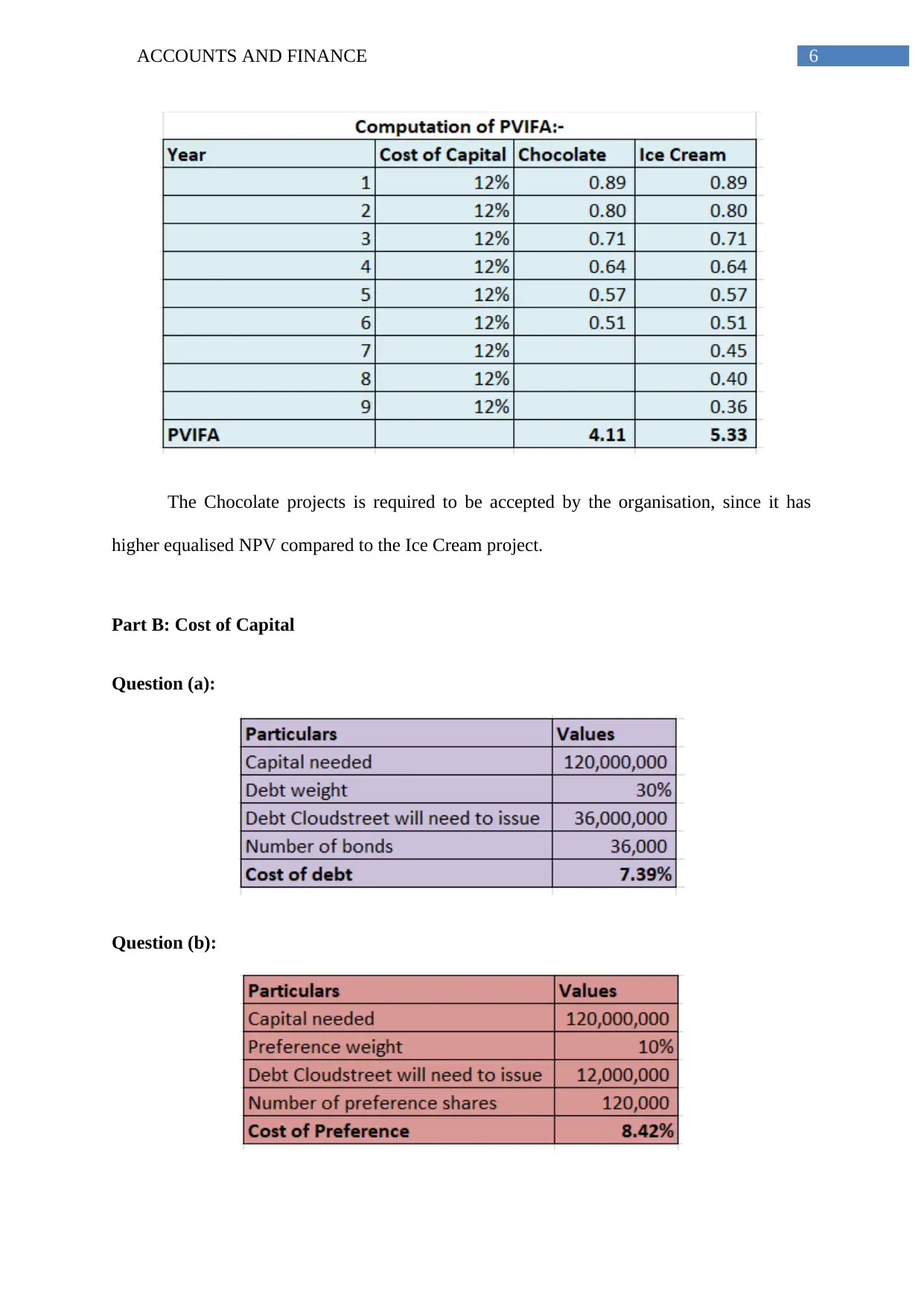
6ACCOUNTS AND FINANCE
The Chocolate projects is required to be accepted by the organisation, since it has
higher equalised NPV compared to the Ice Cream project.
Part B: Cost of Capital
Question (a):
Question (b):
The Chocolate projects is required to be accepted by the organisation, since it has
higher equalised NPV compared to the Ice Cream project.
Part B: Cost of Capital
Question (a):
Question (b):
Paraphrase This Document
Need a fresh take? Get an instant paraphrase of this document with our AI Paraphraser
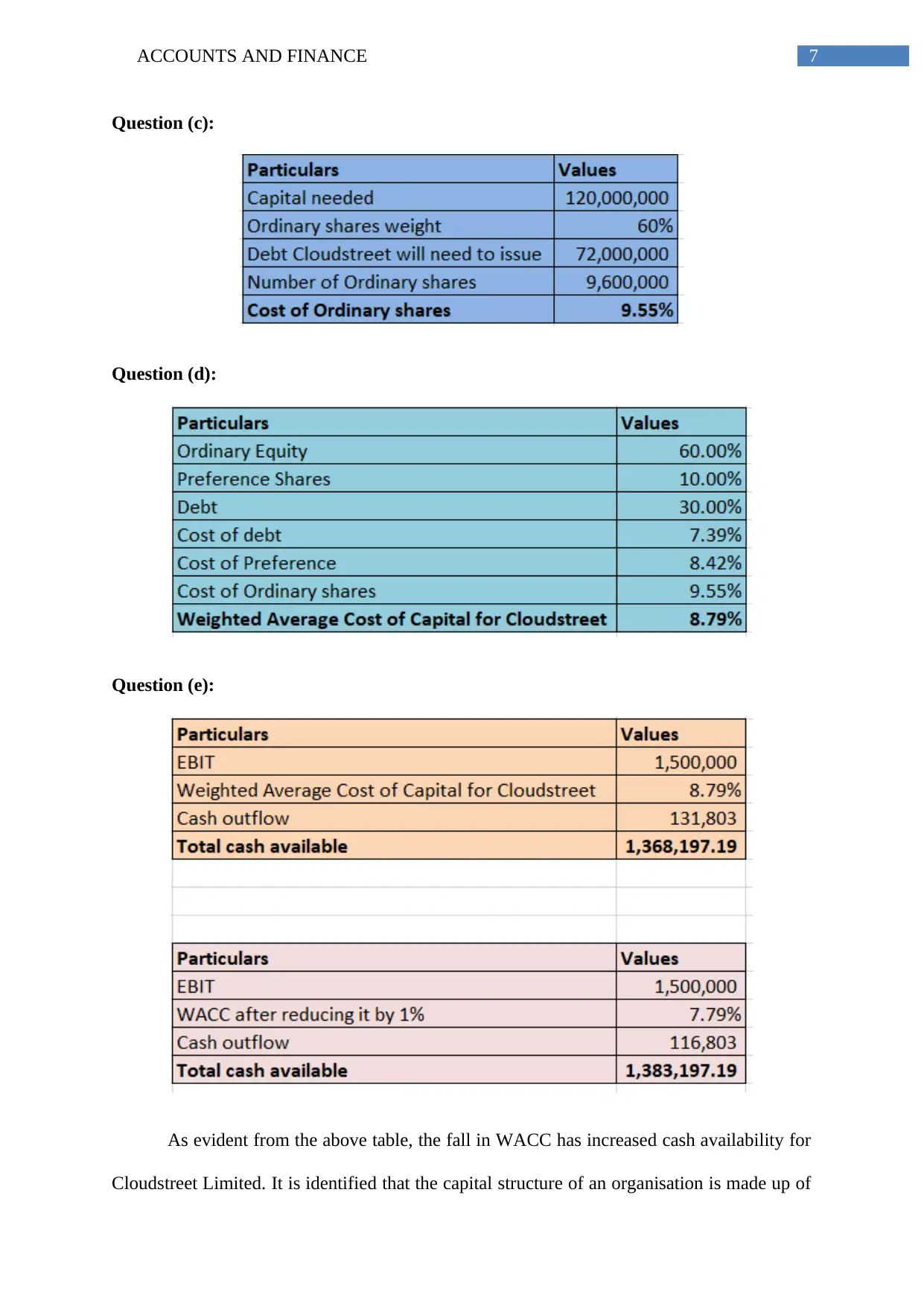
7ACCOUNTS AND FINANCE
Question (c):
Question (d):
Question (e):
As evident from the above table, the fall in WACC has increased cash availability for
Cloudstreet Limited. It is identified that the capital structure of an organisation is made up of
Question (c):
Question (d):
Question (e):
As evident from the above table, the fall in WACC has increased cash availability for
Cloudstreet Limited. It is identified that the capital structure of an organisation is made up of
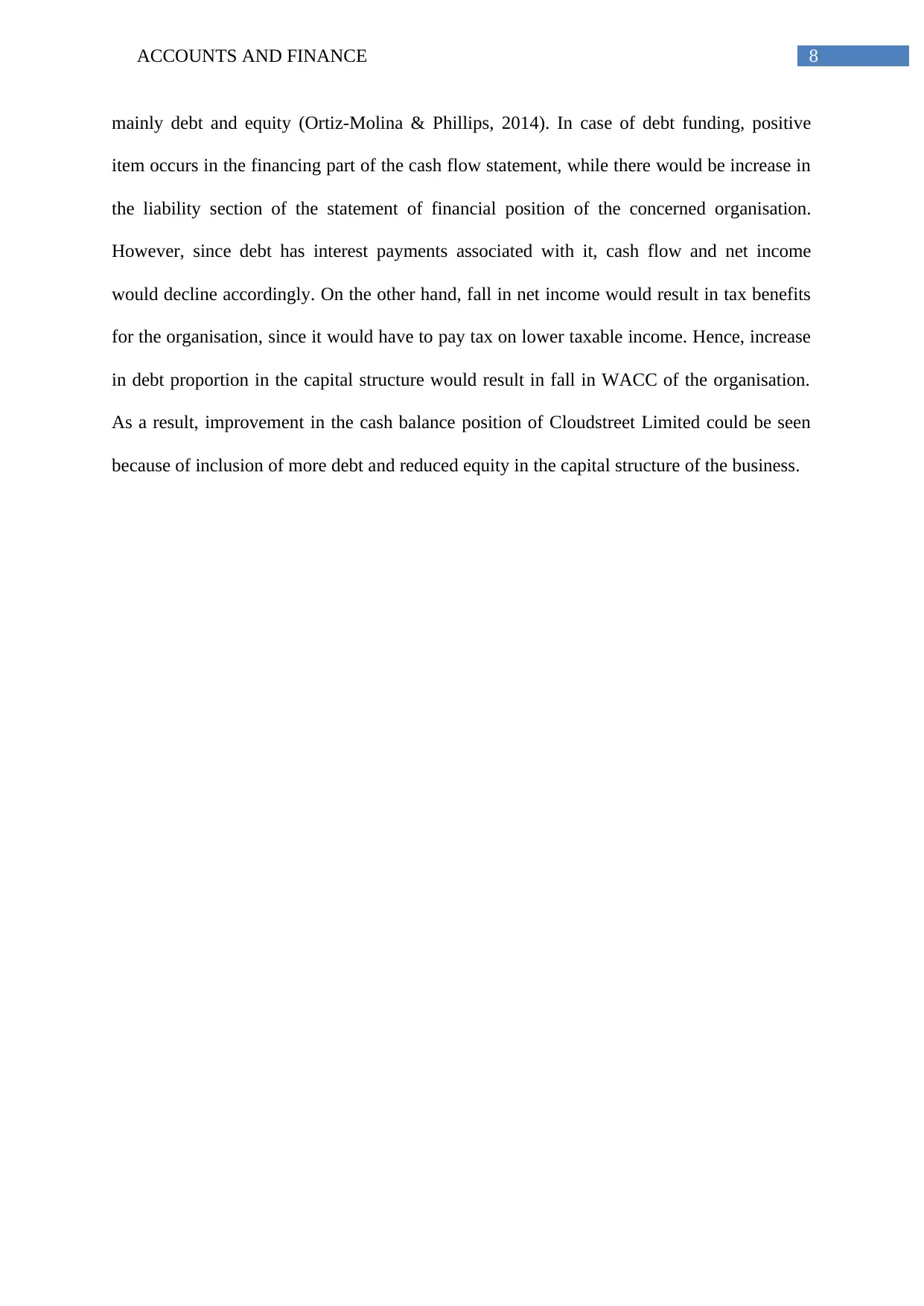
8ACCOUNTS AND FINANCE
mainly debt and equity (Ortiz-Molina & Phillips, 2014). In case of debt funding, positive
item occurs in the financing part of the cash flow statement, while there would be increase in
the liability section of the statement of financial position of the concerned organisation.
However, since debt has interest payments associated with it, cash flow and net income
would decline accordingly. On the other hand, fall in net income would result in tax benefits
for the organisation, since it would have to pay tax on lower taxable income. Hence, increase
in debt proportion in the capital structure would result in fall in WACC of the organisation.
As a result, improvement in the cash balance position of Cloudstreet Limited could be seen
because of inclusion of more debt and reduced equity in the capital structure of the business.
mainly debt and equity (Ortiz-Molina & Phillips, 2014). In case of debt funding, positive
item occurs in the financing part of the cash flow statement, while there would be increase in
the liability section of the statement of financial position of the concerned organisation.
However, since debt has interest payments associated with it, cash flow and net income
would decline accordingly. On the other hand, fall in net income would result in tax benefits
for the organisation, since it would have to pay tax on lower taxable income. Hence, increase
in debt proportion in the capital structure would result in fall in WACC of the organisation.
As a result, improvement in the cash balance position of Cloudstreet Limited could be seen
because of inclusion of more debt and reduced equity in the capital structure of the business.
⊘ This is a preview!⊘
Do you want full access?
Subscribe today to unlock all pages.

Trusted by 1+ million students worldwide
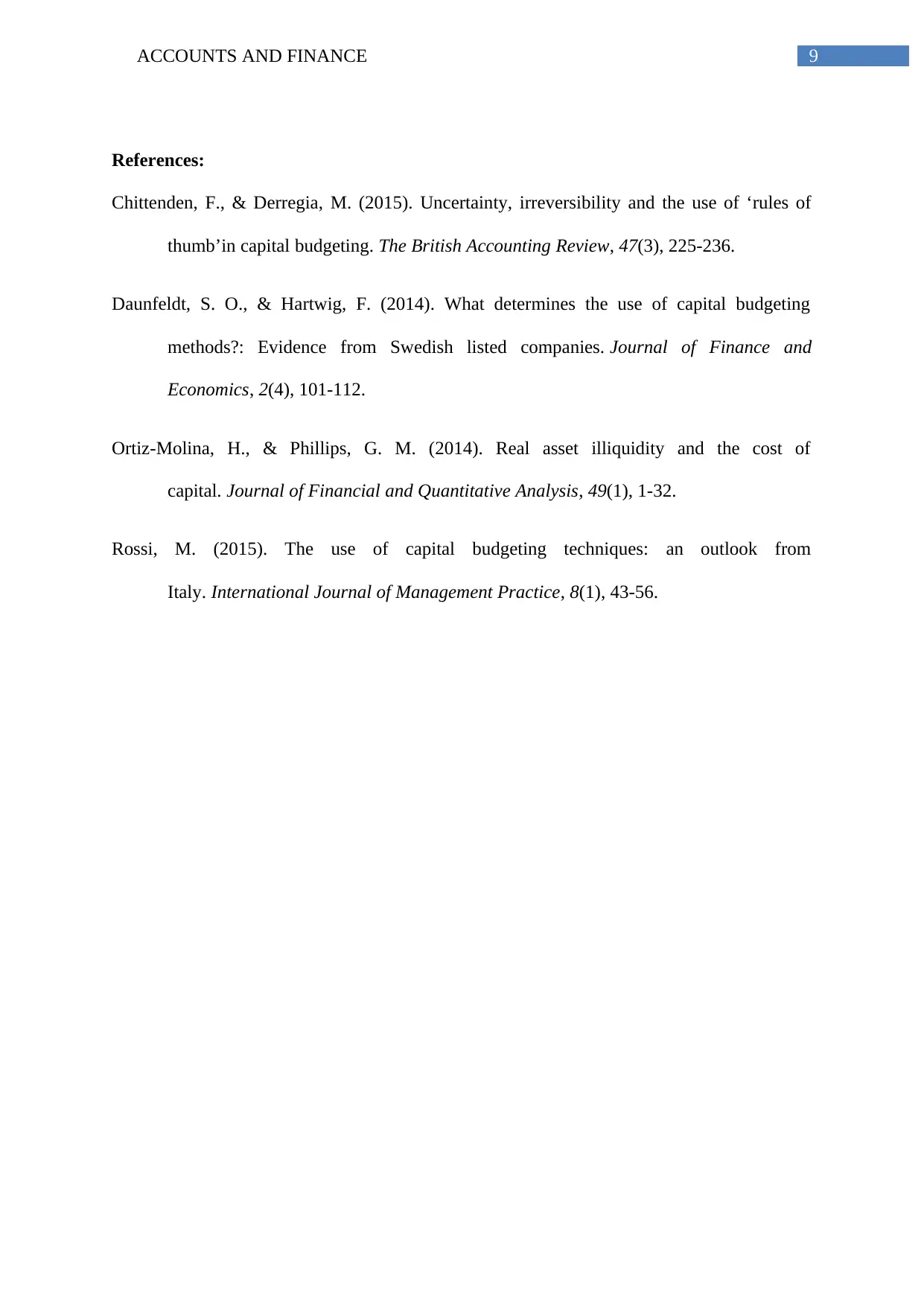
9ACCOUNTS AND FINANCE
References:
Chittenden, F., & Derregia, M. (2015). Uncertainty, irreversibility and the use of ‘rules of
thumb’in capital budgeting. The British Accounting Review, 47(3), 225-236.
Daunfeldt, S. O., & Hartwig, F. (2014). What determines the use of capital budgeting
methods?: Evidence from Swedish listed companies. Journal of Finance and
Economics, 2(4), 101-112.
Ortiz-Molina, H., & Phillips, G. M. (2014). Real asset illiquidity and the cost of
capital. Journal of Financial and Quantitative Analysis, 49(1), 1-32.
Rossi, M. (2015). The use of capital budgeting techniques: an outlook from
Italy. International Journal of Management Practice, 8(1), 43-56.
References:
Chittenden, F., & Derregia, M. (2015). Uncertainty, irreversibility and the use of ‘rules of
thumb’in capital budgeting. The British Accounting Review, 47(3), 225-236.
Daunfeldt, S. O., & Hartwig, F. (2014). What determines the use of capital budgeting
methods?: Evidence from Swedish listed companies. Journal of Finance and
Economics, 2(4), 101-112.
Ortiz-Molina, H., & Phillips, G. M. (2014). Real asset illiquidity and the cost of
capital. Journal of Financial and Quantitative Analysis, 49(1), 1-32.
Rossi, M. (2015). The use of capital budgeting techniques: an outlook from
Italy. International Journal of Management Practice, 8(1), 43-56.
1 out of 10
Related Documents
Your All-in-One AI-Powered Toolkit for Academic Success.
+13062052269
info@desklib.com
Available 24*7 on WhatsApp / Email
![[object Object]](/_next/static/media/star-bottom.7253800d.svg)
Unlock your academic potential
Copyright © 2020–2025 A2Z Services. All Rights Reserved. Developed and managed by ZUCOL.





